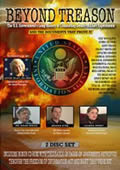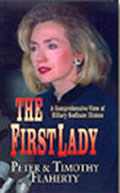GINGRICH'S FAILED "INTERNAL PASSPORT"
By
Jon Christian Ryter
December 21, 2011
NewsWithViews.com
Newton Leroy McPherson is not a man that America can trust anymore than his mother could trust his birth father. Newton's mother, 16-year Kathleen "Kit" Daugherty was "seeing" 19-year old Newton Searles McPherson. The marital union—which occurred when her parents realized their minor daughter was pregnant—was not a marriage made in heaven. It lasted 3-days, and served only to legitimize Baby Newt. As you likely have guessed, Baby Newt became Newt Gingrich, the 58th Speaker of the US House of Representatives. Newt's birth father got drunk and beat up his mother ending their marriage before the pedals on the proverbial bridal bougquet had even wilted.
Kit Daugherty married a US Army officer, Robert Gingrich in 1946. Too bad none of the steel in Bob Gingrich's character found its way into his newly adopted son. In high school, Newt Gingrich developed a crush on his math teacher, Jackie Battley. They were caught in a tryst. Today they prosecute teachers for seducing their students. She was Newt's first "love." He married her in 1962 when he was 19. Gingrich has been married three times. His two previous marriages ended in divorce after the former House Speaker had affairs with younger women—and at a time when his current wife (in both instances) was seriously ill. Wife number two was Marianne Ginther. Wife number three, the current Mrs. Gingrich, is Callista Bisek. If you think that Senator John Edwards—John Kerry's running mate in 2004—was a snake for having an affair while his wife was slowly dying of cancer, then Gingrich is a double-headed viper.
By the mid-1960s, supported by Jackie's sweat equity investment in their marriage, Newt was studying at Tulane University, working on his Ph.D in history. When he graduated Newt and Jackie had two daughters. He had a doctorate in education and not much else. Except, he knew how he planned to spend the rest of his life. In Congress. He took a teaching job at the academically second rate West Georgia College. He took the job only because WGC sat plum in the middle of the 6th Congressional District, a seat Gingrich believed he would eventually win. The seat was held by then 10-term Democratic Congressman Jack Flynt. Gingrich launched his first campaign against Flynt in 1974—and lost. Gingrich tried again in 1976 and lost again. In 1978 Flynt retired. Gingrich won the seat. Flynt, the Democrat, was much more conservative than Gingrich, the Republican. It is unlikely that John James "Jack" Flynt, a retired US Army calvary officer and aid-de-camp to Brig. Gen. Robert W. Grow in France in 1944, and a gun-rights advocate, would have ever tried to surreptitiously impose a Nazi-style internal passport on the American people. Gingrich did.
The question the American people—conservatives and liberals alike—need to be asking themselves is—do they want a man in the White House who has already tried, and failed, to impose an Internal Passport on them? The Soviets did it to the Russian people in 1917. The fascists in Italy did it in 1924. The Nazis did it to the German people in 1933, and Newt Gingrich tried to do to the American people in 1998.
The article that follows is a portion of the text in Chapter Nine, "The Disavowed White House Protocol," from my book, WHATEVER HAPPENED TO AMERICA? published by Hallberg Publishing in 2000. It deals with the attempt on the part of the Clinton Administration to surreptitiously include in the Immigration Reform Act of 1996 a Hillary Clinton provision (which had initially been included in Clinton's failed Health Security Act of 1993—Hillarycare) that would force every American to carry a biometric identity card that had a GPS tracking chip embedded in it. The experiment to make sure they could track 300 million people simultaneously took place in 5 western States in 1998 in a healthcare experiment paid for by the Robert Wood Johnson Foundation that was neither approved nor funded by Congress—which meant it was completely off the radar screen.
Low income women with dependent children were the target of the test. Each mother was provided a biometric Health Passport card (pictured here). The entire medical history of the of the benefits recipients were stored in what was initially a one megabyte chip embedded in the card. In addition, recorded on the card was the medical history of each benefits recipient. Based on the assumption that low income people are more transient than middle income households, one other element was added to the benefits card—a GPs tracking chip that contained a 24-digit personal identifier (that is now assigned to every taxpayer in the world). When world government is achieved, the personal identifier will replace the American social security number.
In the summer of 1999, the Department of Health and Human Services held a follow-up conference in Denver, Colorado to report on the progress of the Robert Wood Johnson Foundation funded experiment. It was a huge success. As senior level Clinton Administration healthcare executives watch big screen TVs that were strategically placed around the room, they were shocked and amazed to see a thousand points of light appear on the screens. Each minute speck of light, they were told, represented one benefits recipient. In urban areas, the specks morphed together and appeared as large blobs on the map. The televisions zoomed in from the five State map to a single State. Then, to one county, one community, and then one zone within that community and finally, down to one dwelling. The DHHS, the attendees were told, had the ability to isolate and track each recipient. But the government would do so only to make sure that the children were receiving the vaccinations they required when it was time to get them.
Attending a November 11, 1993 White House strategy meeting that was described in the White House Protocol for that date, were the following Clinton Administration officials. The meeting was chaired by President Bill Clinton. Attending, and identified only by their initials were HRC, TFM, RN, IM, GS, and RH. (The identities of the attendees are revealed on page 218 of my book.)
After providing updates on NAFTA, Hillarycare, outlawing tobacco, and the cooperation the Clintons were receiving from CNN on killing negative news stories about the Clintons, "...[t]he President brings up the subject of the National Identity Card in conjunction with the implementation of the Health Security Act. He stresses the necessity of having all Americans being required to possess and carry such a card. He stresses that it would simplify the task of law enforcement, in cutting down on serial killers and would allow various federal agencies to keep track of a population that is too highly mobile. (GS: I think this issue will present a major problem with Congress. Most people object to having to carry what amounts to an internal passport. They will equate this with Nazi Germany or the former Soviet Union. I think if we can't get the National Health Card through, we could always turn to the INS issue and fabricate the excuse of preventing illegal aliens from taking US jobs or getting free medical care. I think there would be more acceptance to the card idea if we added this to it) (HRC: Well, I agree with that. After all, if all the provisions of the Health Security Act passed, as they must...unaltered in any way...every citizen must by law be registered with the program even if they have no intention of using its services. That must be made law...a very important part of this program. Note that it will also help the government track down and prosecute fathers who are delinquent in child support payments. By linking this with the Social Security databanks, we should be able to force deadbeat dads to pay right at the workplace."
When the Health Security Act went down in defeat, some members of Congress—on both sides of the aisle—did attempt to insert a National Identity Card into the Immigration Reform Act of 1996. According to Allen Kay, who was, at that time, the press secretary for Congressman Lamar Smith [R-TX] in a telephone interview with me on Jan. 17, 1997, "effort" on three occasions during the floor debate on HR 220 to initiate what Smith's office called a "National Identity Card dialogue." The Republican majority and Smith, who drafted the legislation that would become Public Law 104-208, Kay said, saw no need for such an extreme measure and successfully thwarted efforts to introduced the concept in the immigration debate. "Congressman Smith," Kay reiterated, "as well as most members of Congress, saw no need for a National Identity Card. Because they did not believe a National ID Card would solve the problems addressed in HR 220, they were not prepared to discuss it." One question came to mind as Kay spoke: if no one—particularly Lamar Smith—saw a need for it, why did Smith draft the measure? That was a question that needed more research before I was ready to frame the question to Smith's press secretary. (It's always better to know the answers to the questions you plan to ask before you ask them.) When I had the answer Kay was no longer taking my calls.
The provision to allow the creation of an internal passport in the United States was quietly voted on and passed in the Senate version of the bill before it went to joint conference where the differences between the House and Senate bills (which have been voted and passed by the members) where the differences between the House and Senate versions are supposed to be ironed out, and everything without the consensus of a majority both chambers of Congress is stripped from the final version of the bill before it was sent to the White House to be signed into law.
According to Congressman Bob Barr [R-GA] when the National ID Card surfaced in National Highway Traffic Safety Administration regulations in 1998, no notice of the provision's inclusion in Public Law 104-208 was ever sent to the House. Nor was there a Senate floor debate on the subject. As the bureaucrats learned from the House debate, talking about an internal passport disguised as a benign National ID Card that was supposed to keep illegals from taking the jobs of US citizens, was tantamount to killing it.
Do you remember the 1995-96 budget battle when the GOP shut down the federal government in order to force the Democrats to live within their means? Everyone does. It was good media. To bad everyone was paying attention to the talking heads and no one was watching the legislative shell game taking place in the House under the watchful eye of Speaker Gingrich [R-GA], Minority Leader Dick Gephart [D-MO], Senate Majority Leader Bob Dole [R-KS] and Senate Minority Leader Tom Daschle [D-SD]. The same sleight-of-hand that inserted half-of-a-bill into the Immigration Reform Act of 1996 was used to inserted the same bill in the House version of the bill to the Omnibus Budget Act of 1996. When the House voted on the Budget Bill, it appears they also voted on, and passed, the National ID Card that would be implemented by the NHTSA sometime down the road.
According to Barr, who appeared as a guest on a Paul Weyrich's America's Voice segment hosted by Coalition for Constitutional Liberties Director Lisa Dean on July 13, 1998 to talk about the new national drivers' license being implemented by the NHTSA. Gingrich's internal passport had been innocuously disguised as a drivers' license. But as everyone knows, when it looks like a duck, walks like a duck and quacks like a duck, it's a duck.
Barr told Lisa Dean "...this bill (the Omnibus Budget Bill) was several thousand pages long [and] was not distributed to House members before the vote. The only chance any of us might have had to have seen this bill was while it was sitting on the floor during the debate—but there was no debate on it. No chance for review. It was slipped in as a mickey and was enacted into law because it was part of a very important omnibus spending bill."
Barr then told Dean that he and Congressmen Ron Paul [R-TX] and Mac Collins [R-GA] were introducing legislation to abolish the provision in law that gives the NHTSA authority to create a national identity card. Or, for that matter, any system that would allow the federal government or any of its agencies, the right to implement such a card by prohibiting the funding of such projects in the future. Of course, as history has repeatedly confirmed, its hard to milk the cow after its left the barn.
Funding this infringement on States' rights by the NHTSA was not viewed by the federal bureaucracy as a problem since the costs for upgrading drivers' licenses falls on the States. And, although Congress passed the Unfunded Mandates Reform Act of 1996 (Public Law 104-4) to prevent the federal government from forcing the States to foot the bill for costly bureaucratic federal programs and regulations when the cost to the States to comply exceeds $100 million (collectively). The NHTSA did another sleight-of-hand and projected the cost of standardizing drivers' licenses nationwide at only $72 million. NHTSA documents show the government made their projections based on the average cost to implement the program in 5 sparsely populated States. In reality, the cost to implement the program in California, Illinois, Michigan, New York and Texas alone would be almost double their estimate—well over $200 million.
In an Open Letter to Congress on July 15, 1998, Dean said, "...This plan pushes us to the brink of tyranny, where citizens will not be allowed to travel, open bank accounts, obtain health care, get a job or purchase firearms without first presenting the proper government papers. The authorizing section of the law and subsequent NHTSA proposal is reminiscent of the totalitarian dictates of the Politburo members of the former Soviet Union, not the Congress of the United States of America."
Congressman Barr said as much himself. "This is not some theoretical exercise. This is a very real, very serious problem with practical ramifications for every citizen in our country, ranging from everything from gun control to bank accounts to government [control] over travel to seeing a doctor or enrolling child in school. Once this program goes into effect, if we allow it to, then the government will be able to not only track everything that an American citizen does, but they will be able to stop citizens from doing certain things—if we don't do something very quick. We will be faced with a government that is all-powerful, and an executive branch that can override either of the two branches of government at will."
Impressed with Bob Barr's stance, Paul Weyrich and Dean scheduled a meeting with Barr at his office on Tuesday, July 28, 1998 to see how the Free Congress Foundation could help Barr kill the funding for the government's all-purpose internal passport. Barr's opening remark stunned them. "At the moment," he told them, "there isn't anything I can do about killing the funding to implement the national ID card." He added that he was backing off as a favor to Lamar Smith. Barr said Smith did not view the national drivers' license as a threat, and wanted to give it a chance.
Within a day or two, something happened to change his mind. A few days later Barr and Dr. Paul introduced the legislation to defund the national drivers' license and suspend it in bureaucratic limbo, but unable to kill the measure outright. Once introduced, the bill was shelved by the Speaker. It was not going to even get on the floor for a debate. Soon every American would be carrying a drivers' license that would be their passport to cross a state line, transact business or rent a home. Barr hit the talk show circuit. People began asking questions about the new national drivers' license. On August 4, 1998, more to appease Barr than to accomplish anything, a hearing was held in the office of the Transportation Subcommittee. Barr, Dr. Paul, Smith and several Congressional staffers attended. Barr requested that the "comment period" on the legislation be reopened. That is, of course, like discussing the changes you would like to make in the script of a movie you just watched.
Barr requested that "interested parties" be allowed to reconsider the NHTSA's proposal and suggest changes, adding that "...I don't think Americans are interested in giving the federal government unprecedented power to track and identify them. Hopefully, these hearings will be the beginning of the end of efforts to create a national identification system." Barr quickly learned it wasn't going to be that easy. Barr and Ron Paul hit the talk show circuit. Smith—the shill for the leadership—and Gingrich and Gephart al denied knowing about the language that was creating an internal passport, doggedly pushed House Appropriations and Transportation Subcommittee chairman Frank Wolf [R-VA] to derail Barr's attempt to derail the national drivers' license.
On Tuesday, October 6, 1998 Gingrich agreed to eliminate Barr's provision from the Transportation Bill. After an overnight battle, Barr won a temporary victory—support from several other House members led by Majority Whip Tom Delay who met with Gingrich to demand why Smith and Gingrich were zealously pushing for something the American people vehemently opposed. Delay told Gingrich that, beginning the following morning, he would be on every talk show in America, and any chance that Gingrich had of being reelected would die. Fearful of voter backlash, Gingrich was forced to cave. Barr's measure to defund the national drivers' license was enacted.
During that midnight battle, on Tuesday October 6, Newton Leroy McPherson Gingrich showed himself to be one of the most dangerous politicians in Washington, DC. Suffering from a stinging rebuke from his own party after the GOP lost five House seats in the election held on Nov. 4, 1998, Gingrich announced on Nov. 5—one day after winning reelection to his 11th term—that he would not only stand down from seeking reelection as Speaker, he would resign from the House of Representatives as well.
Newt Gingrich is even more dangerous today. When he left office, Gingrich formed a political consulting group called The Gingrich Group. He insists he was not a lobbyist. Newt Gingrich is wholly a product of Washington. And, by definition, he is and was, a lobbyist since 1999. Federal law defines lobbying as "...contacts and any efforts in support of such contacts, including preparation or planning activities, research and other background work that is intended, at the time of its preparation, for use in contacts and coordination with the lobbying activities of others." Further, a lobbying contract is "...any oral, written or electronic communication to a covered official that is made on behalf of a client with regard to congressmen and senators, among others."
| Subscribe to the NewsWithViews Daily News Alerts! |
Those words describe Gingrich's activity from the time he left office. For example, Fannie Mae and Freddie Mac hired Gingrich to "...build bridges to Capitol Hill Republicans and develop an argument on behalf of the company's public-private structure that would resonate with conservatves seeking to dismantle it." Depending on who's reporting it,. Gingrich received somewhere between $1.5 and $1.8 million for consulting work done for Fannie and Freddie. He originally claimed he only received $300 thousand for work done for them. Since leaving Congress, industry clients shelled out $35 million to The Gingrich Group. What did they get in return? According to Gingrich, a tutorial on American history. Gingrich reiterated that he "...[does] no lobbying of any kind. I never had." For Fannie and Freddie he advised them on the War of 1812 which, as you know, is critical information to have when you are guaranteeing home loans—and are trying simultaneously to win over Republicans who want to dismantle your organization.














 Share
This Article
Share
This Article





